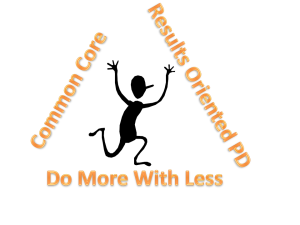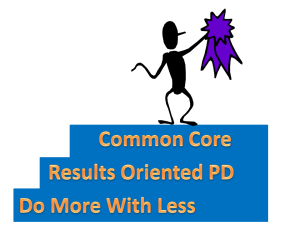The Hidden Challenge Facing Education Industry Managers
This post is written by Farimah Schuerman, Managing Partner of Academic Business Advisors.
Are you a senior manager of a company that develops and
sells instructional solutions, especially for
 math and reading? If so, you've
math and reading? If so, you've
felt the pain of the recession and may wonder how you can best survive the
"new normal." One way to ensure your company's survival is to see the
current situation from your customer's view. What's causing them to more
carefully consider every purchase may run deeper than you think.
The rush to meet the guidelines for the Common Core
standards and the anxiety around meeting the objectives of the related
assessments is masking a much deeper and more daunting challenge school
districts’ leadership team: Change Management.
While leaders of commercial enterprises have understood and embraced practices
that guide a corporation through change when outside forces require it, this has
never been a part of the education culture.
Now, school personnel at all levels are being bombarded with change. If
you understand the forces behind the change and can help administrators cope
and adapt, you could find your business thriving, even during a down economy.
Three Forces Driving Change: What’s
the Impact on School Administrators?
Driving Force #1: Common
Core Standards Are Forcing New Processes
The shift to Common Core has required districts to take a
long, hard look at which processes they can keep doing as before, and which
must change. Teaching is shifting from
knowledge-based, to learning-based approaches. It’s not what the teacher knows,
it’s what the students learn; students need to grasp concepts, not commit facts
to short term memory, and to demonstrate that they can apply what they have
learned to new problems. Good teachers
have used this approach for years with success, but many others have not. Successful
companies are already reacting to this catalyst and providing leadership, producing
instructional materials, particularly in reading and math, that use the latest
cognitive research to help teachers help each student learn.
Driving Force # 2: Professional
Development That is Results-Oriented
This leads me to the second pressure point: meaningful
professional development (PD) and related evaluation. Teachers need to be prepared not only to
align instruction to the Common Core Curriculum, but how to extract the best
learning. This involves disrupting
traditional classroom strategies based on the new realities: the use of new
technologies, mainstreaming students with special needs, and problem based
learning, just to name a few. We hear the terms "personalized
learning" and "individualized instruction" which expand on the
concept of differentiated instruction. I wonder how many teachers are equipped
to teach this way, especially as class sizes grow larger than we've experienced
before. The best PD providers are building both product-specific and generalized
tools for helping teachers successfully make these changes and for
administrators to better manage them.
Driving Force #3: Doing
More with Less
A third pressure is the combination of diminished or flat
school funding while expenses, particularly those around staff benefits, are on
the rise.
In this time of greater accountability, teachers,
administrators, and materials are being measured, evaluated, and judged, even
when outcomes can’t be specifically tied to specific actions. Diminished
funding also comes at a time when there is momentum to acquire and support costly
technology solutions which promise to improve learning. A firehose of new
technology applications have the potential to provide more reliable collection
and analysis of student data. But, administrators feel forced to make stressful
decisions and often feel the frustration that there may be no "good"
decision, just the best one they can make under bad circumstances and with
incomplete information or unbiased guidance. Successful companies are finding
ways of tying their solutions to both fiscal austerity and high achievement.
Strong Company Leaders to the Rescue
So what's the point of painting this negative picture? It's not to depress you, but to remind you
that in order to be successful in this environment, everyone who works for your
company must understand these forces and be empathetic. Company leaders,
starting with the CEO and every employee must understand the buyer's
perspective when trying to get excellent products, with game-changing
possibilities, into the hands of students who need them. So, here are some guiding questions I suggest
you consider as a leader of an organization that serves the school market:
- How does your product (or service) make the
buyer's life better? - Can you articulate how your product solves a
pressing problem? - Does the problem your product or service
addresses keep school leaders up at night? - What else is required, or has to change for educators
to implement your product successfully and do you understand how the
implementation will be managed? - Does your product or service replace a product
that is established and gets the job done – not as well as yours, but works? - How much teacher training will be required to
effectively utilize your product or service and when do you expect this
training to be provided? - When your product is implemented, will instructional
time have to be managed differently? - Will using your product require that students are
identified in a new or different way?
Four Steps You Can Take Today on the Pathway to Success
1. Help Potential
Customers Secure Funds
How will educators pay for your product? While this is a basic question, the answer is
not always straightforward. If grants
are necessary, how will they be secured?
How can you help? Does the use of
 your product save some other expense?
your product save some other expense?
Credit recovery products have used this approach, retaining students
brings income to the district that can cover the expense. What strategies like
this could you use to reduce perceived costs?
2. Train and Support Your
Sales Team
It is critical that your sales team can display empathy for school
administrators who are under fire. Some
ways they do this are by confirming timing and by offering alternatives for
scheduling, and by being sensitive to the timing of other initiatives that are
going on in the district. They need to develop a deep understanding of the
district’s priorities. Administrators
are pulled into committees, community meetings, staff trainings and are
thrashed around by external forces can affect the salesperson's ability to drive
deals forward on your company's schedule.
3. Think Through the Entire
Process from Sale to Implementation
Understanding the principals of change management will help
your company guide and support your customers through the challenges they
face. When you are proposing a product
adoption, think about how it will affect the district or school and take the
time to plan the change with the administrators. Look at calendaring with them. Offer support for how data might flow if the
product has instructional impact. Think
about how teachers will need to do things differently, and figure out how best
to stage those changes so they are as easy as possible. Assign support staff to
monitor these changes; don't encumber the sales team with that task, that's not
their role, or their expertise. Supporting implementations will distract them
from their principal function: driving new sales. Take time to help your entire
staff understand the current dynamics of change so that each one can be
empathetic and supportive during any interaction with customers or prospects.
4. Plan for the Future
Finally, senior management needs to be prepared that sales
are slower under these circumstances, and you need to be cognizant of the cash
flow implications of this slowed decision-making process. Unless you have a "must-have"
product, you will need to tighten your belts and hunker down. Keep these points
in mind!
You can listen to a 15 minute discussion on these issues with Glen McCandless of Selling to Schools, Mitch Weisburgh, and me on Blog Talk Radio.
This process of re-imagining products and services requires
a radical change in underlying beliefs; it’s what in 1962 Thomas Kuhn called a paradigm
shift. While business leaders can attempt this process internally, it
is often best facilitated by outsiders, because it involves a significant shift
in perception.
Of course, if you do seek outside help, we hope that you
will consider Academic Business Advisors.

